Data from the fourth edition of State Energy Efficiency Index (SEEI 2021-22) indicates an overall improvement across most of the States. However, there are varying trends across the 7 sectors identified for SEEI 2021-22. The report notes that Andhra Pradesh, Karnataka, Kerala and Telangana are the only states with a proactive approach to scale up Energy Efficiency programmes.
Data from the fourth edition of the State Energy Efficiency Index i.e. SEEI 2021-22 indicates an overall improvement across most of the States. In the previous story, we reviewed the overall performance of the States/UTs in comparison with the earlier indices and with the other states in the same consumption grouping. While the overall index shows a positive trend in comparison to previous editions, there are varying trends across the 7 sectors identified for SEEI 2021-22. Here is a detailed review of each of the sectors.
Andhra Pradesh, Karnataka & Kerala score high in Industry Sector
The industry sector has the highest total final electricity consumption (TFEC) with 41% of the total consumption of India in 2020-21. In SEEI 2021-22, this sector contributes to 21% of the total points. The energy efficiency of the sector is measured in 5 indicators, of which 2 are common indicators (4 points) and 3 are programme-specific indicators (17 points). As indicated in the previous story, performance indicators were introduced in the current index. These programme-specific indicators, carrying a larger weightage are measured in the various programmes implemented by states for large industries, MSMEs and PSUs.
Andhra Pradesh scored the highest for Industry Sector with 18.5 points, followed by Karnataka, Kerala & Rajasthan at 15.5, 14.5 & 14 points respectively.

The fall in the score across many States is the more visible trend relating to this sector.
- Andhra Pradesh and Jharkhand have comparatively improved their scores in SEEI 2021-22 compared to other states. The score of Jharkhand was up by 28% while that of Andhra Pradesh was by 24%.
- This is not the case with most other states. Karnataka which has the second-highest score, saw a reduction in its score by 8% compared to SEEI 2020.
- The highest fall in the score was Haryana with a 59% lesser score. Punjab and Maharashtra followed suit with 46% & 39% reductions respectively.
As already indicated, the parameters for SEEI 2021-22 are different compared to that of the previous index. Hence, the fall in the scores does not correlate to a dip in the performance for the criteria that were measured in SEEI 2020.
The performance of the states in Programme-Specific Indicators has a large bearing on the overall score. The better performance of a few of the states is reflected in the initiatives undertaken by them.
- Andhra Pradesh, Karnataka, Kerala, Madhya Pradesh are among the states that have notified specific energy consumption (SEC) reduction targets as mandatory compliance for large industries.
- 14 states including Karnataka, Kerala, Assam, Jharkhand, Rajasthan, Punjab, Odisha, etc. have implemented NMRP (National Motor Replacement Programme). This facilitated the replacement of inefficient industrial motors with EE ones.
- Andhra Pradesh and Kerala have carried out various studies relating to Energy Efficiency to identify energy-saving potential and scope for energy optimisation across various industrial units.
- Andhra Pradesh & Karnataka have implemented the PAT (Perform, Achieve, Trade) scheme which aims at reducing SEC, across 15 & 5 PSUs respectively which have yielded energy savings.
Karnataka secured the highest possible score in Transport Sector, with AP a close second
The transport sector has the third most TFECs with 9% of India’s total energy consumption. Crude oil is the major source of energy requirement in this sector. SEEI 2021-22 has 10 indicators with 8 as common and 2 programme-specific. However, the weightage of them in the total scale is eight each making the total value of the Transport sector on SEEI 2021-22 as 16.
Karnataka scored a perfect 16, while Andhra Pradesh score 15, with it losing out a point in common indicators. Meanwhile, Kerala, which scored 8/8 for common indicators was able to score only 2 in programme-specific indicators. Most of the states showed an improvement in their scores for Transport compared to SEEI 2020. As was the case with other sectors, Tamil Nadu has the highest proportionate decline in its numbers. Its score in the current index is reduced by 32%.
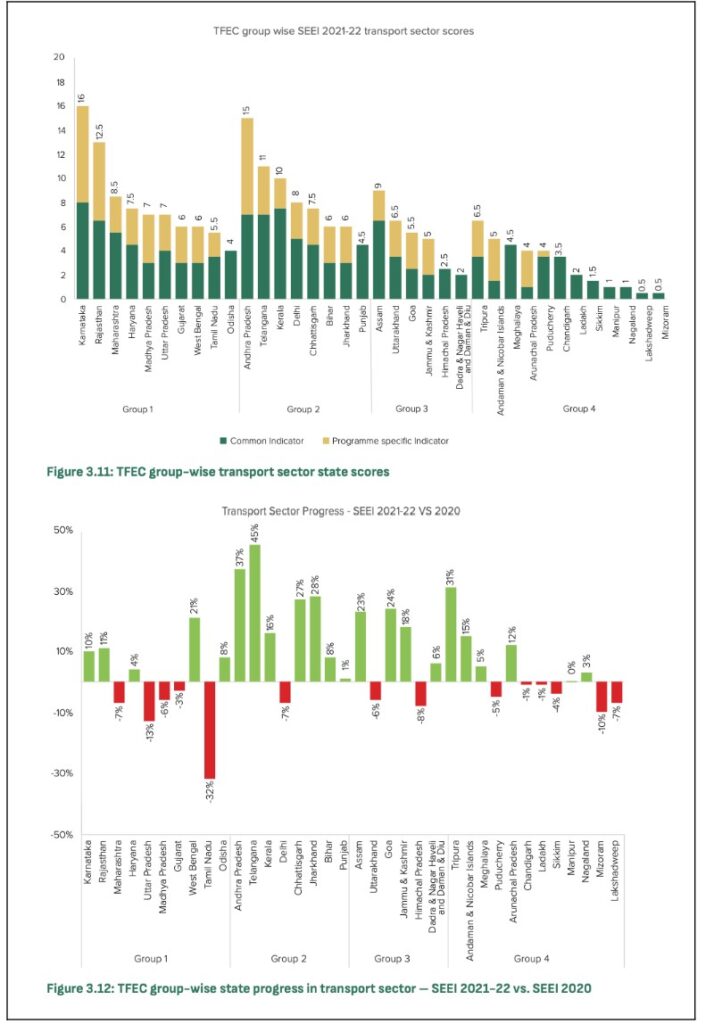
During the period of review, 13 more states reported having a state electric mobility policy, taking the total number to 22. Such policies are key to promoting EV vehicles. Various states have implemented programmes that encourage usage of two-wheeler EVs. Andhra Pradesh has formulated a scheme with the support of NTPC, for the supply of EVs through EMIs to government employees. Various other states – Haryana, Assam, Chhattisgarh, Karnataka, Kerala, Telangana, etc. are among those that have such schemes in place to promote the adoption of EVs.
Kerala, Tamil Nadu & Telangana among the states that reported lesser Transmission and Distribution (T&D) losses
As indicated in the earlier story, Agriculture & DISCOM are treated as separate sectors in SEEI 2021-22.
DISCOMS
There are 5 indicators for DISCOMS with a focus on – Transmission and Distribution losses, Time of day (ToD) and Time of Use (TOU) tariffs, Energy Audits, Smart metering, etc.
T&D loss is an important measure that indicates the operational efficiency of DISCOMs.
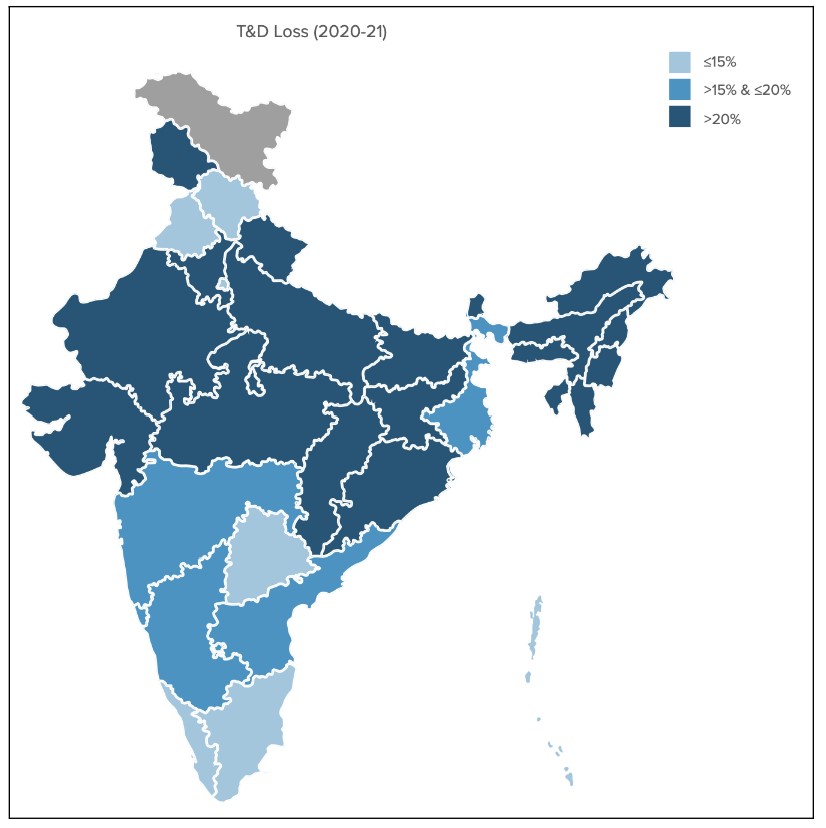
Data indicates that Kerala, Tamil Nadu, Telangana, Punjab & Himachal Pradesh have less than 15% T&D losses. This is reflected in their better scores for the DISCOMS sector. Kerala has the highest score of 9.5, followed by Telangana & Maharashtra. The Bureau of Energy Efficiency’s report “Compendium on DSM measures by DISCOMS” highlight the various initiatives by DISCOMs across India to achieve Energy Efficiency through Demand Side Management (DSM).
Adoption of smart meters enables real-time access to information on energy usage by consumers, which proactively helps DISCOMs in load management and ensuring grid stability. 13 states have so far adopted smart meters.
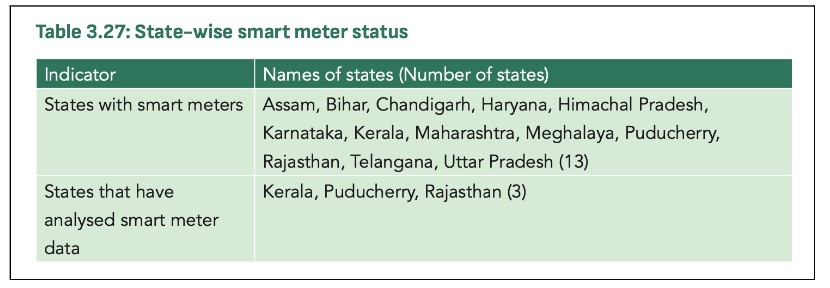
Agriculture
The agriculture sector accounts for 18% of the total energy consumed in India. Improving the sustainability of the sector by reducing farmer energy costs and increasing stability is a key aspect of achieving EE in this sector. Policies around the development of climate-friendly cold chain infrastructure are among the indicators in SEEI 2021-22.
14 states have reported different programmes in agriculture that aim at achieving EE. Andhra Pradesh & Uttar Pradesh have implemented a program to replace old conventional pumps with EE ones. The result was a total energy savings of 210 MU and avoided emissions to the tune of 1.25 MtCO2.
Telangana’s Micro Irrigation project provides assistance to marginal farmers for effective and efficient use of energy and water. Telangana and Karnataka score the highest with 5.5 out of possible 6, with Haryana, Rajasthan, and Kerala scoring 5 each.
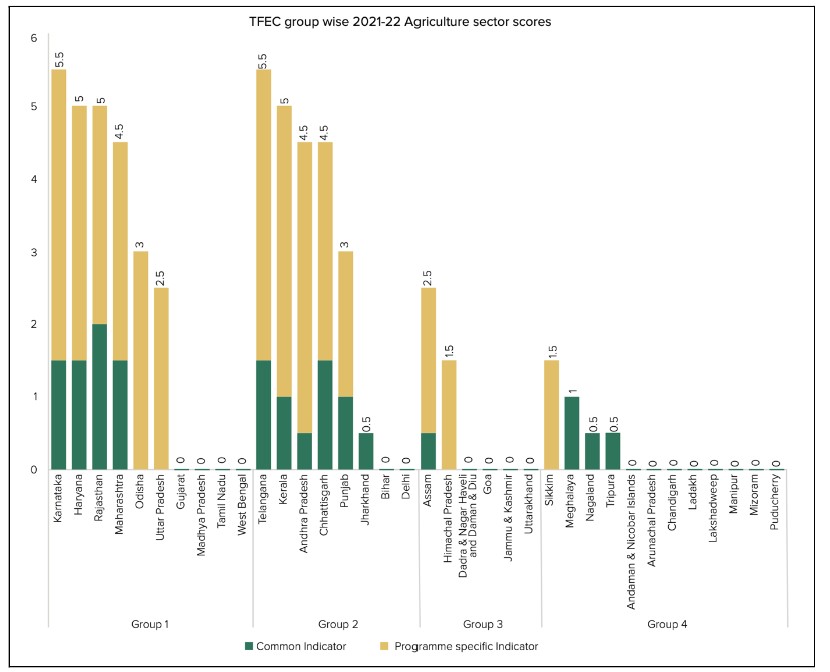
With exception of few States, there is an overall improvement in the score for Buildings sector
In SEEI 2021-22, the share of the building sector is 25% and thus the performance of the states in this sector has a large bearing on the overall SEEI 2021-22. The building sector stands next only to the Industry sector in the overall TFEC and it is projected that its share of the total TFEC would increase by 45% up to 2027 (2017 baseline). Rapid urbanization and economic development drive the growth in energy consumption and hence, it is critical that there is a focus on developing energy-efficiency (EE) strategies in the building sector.
10 indicators are used for evaluation. 7 Common Indicators with a weightage of 10 points and 3 Performance indicators contributing to 15 points on the index. SEEI 2021-22 report notes that the improvements in common indicators and the data provided for programme-specific indicators have contributed to an increase in the overall scores of 20 states.
- Karnataka & Telangana have the highest score with 22.5 and 22. Telangana is also the state with the best improvement compared to the previous edition with a 61% improvement.
- Andhra Pradesh, Punjab & Haryana are the other high-scoring states in the Buildings sector.
- Tamil Nadu has scored only 5 on the index with only a score of 1 for common indicators. Comparison with the previous Index shows a fall of 17%, which is next only to Himachal Pradesh which has a 21% fall in its score.
- Most of the Northeastern states have scored low and also are among the States that have seen a reduction in the score compared to the previous index.
The report notes that across all the states, there has only been marginal progress on policymaking pertaining to budling energy codes. The same is the concern with making a concerted effort to develop institutional capacity in this sector.
However, the states have scored better on the performance indicators.
- 17 states have implemented Building Energy Efficiency Programme (BEEP) to retrofit existing fixtures with EE fixtures. The total energy savings under BEEP across 130 projects in PSUs is 213 million units (MU) in 2020-21 and 2021-22. It is estimated that this initiative has helped in avoiding emissions to the tune of 3.72 million tonnes of carbon dioxide (MtCO2).
- AP has implemented EE measures across 547 court buildings under Building Judiciary Energy Efficiency Project.
- 11 states/UTs including Andhra Pradesh, Chandigarh, Delhi, Gujarat, Haryana, Karnataka, Madhya Pradesh, Maharashtra, Punjab, Telangana and Uttar Pradesh have implemented various EE programmes in Commercial buildings.
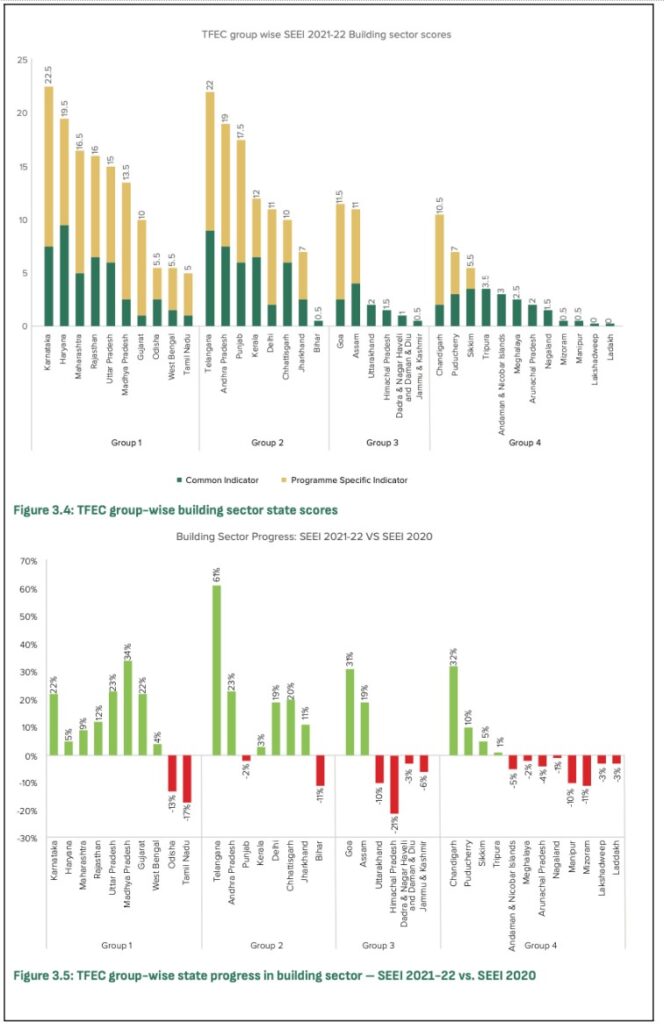
The municipal sector and cross sector are the other sectors that are measured as part of SEEI 2021-22. Apart from Buildings, another sector that is impacted by urbanization is the Municipal sector. The focus for measuring EE in Municipal sector are the achievements around efforts made in street lighting and water/sewage systems.
Karnataka and Kerala are among the states that have implemented programmes to upgrade their streel lighting system. This has contributed towards a comparatively higher score on the index for this sector.
A.P, Karnataka, Kerala and Telangana among the only states with a proactive approach to achieve Energy Efficiency (EE)
As per SEEI 2021-22, it can be ascertained that there has been a considerable progress across the states compared to SEEI 2020. The introduction of program specific indicators in the current index has ensured adoption and implementation dimension being given emphasis in the current index.
Across the sectors, the states whose scores are less than the previous index are the ones which have scored less on the program specific indicators. Infact, many of the common indicators also emphasise on the implemented actions of the states.
In this context, the report states that only a few states have adopted a proactive approach. These are Andhra Pradesh, Karnataka, Kerala and Telangana. In case of most of the other states, it is the adoption and implementation of national policies that has contributed towards improved Energy efficiency.
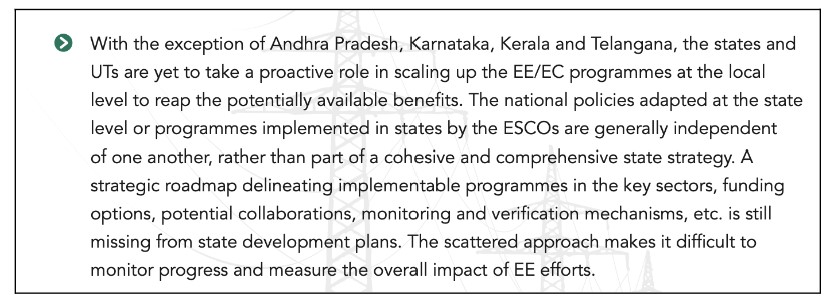
Featured Image: SEEI 2021-22 report


